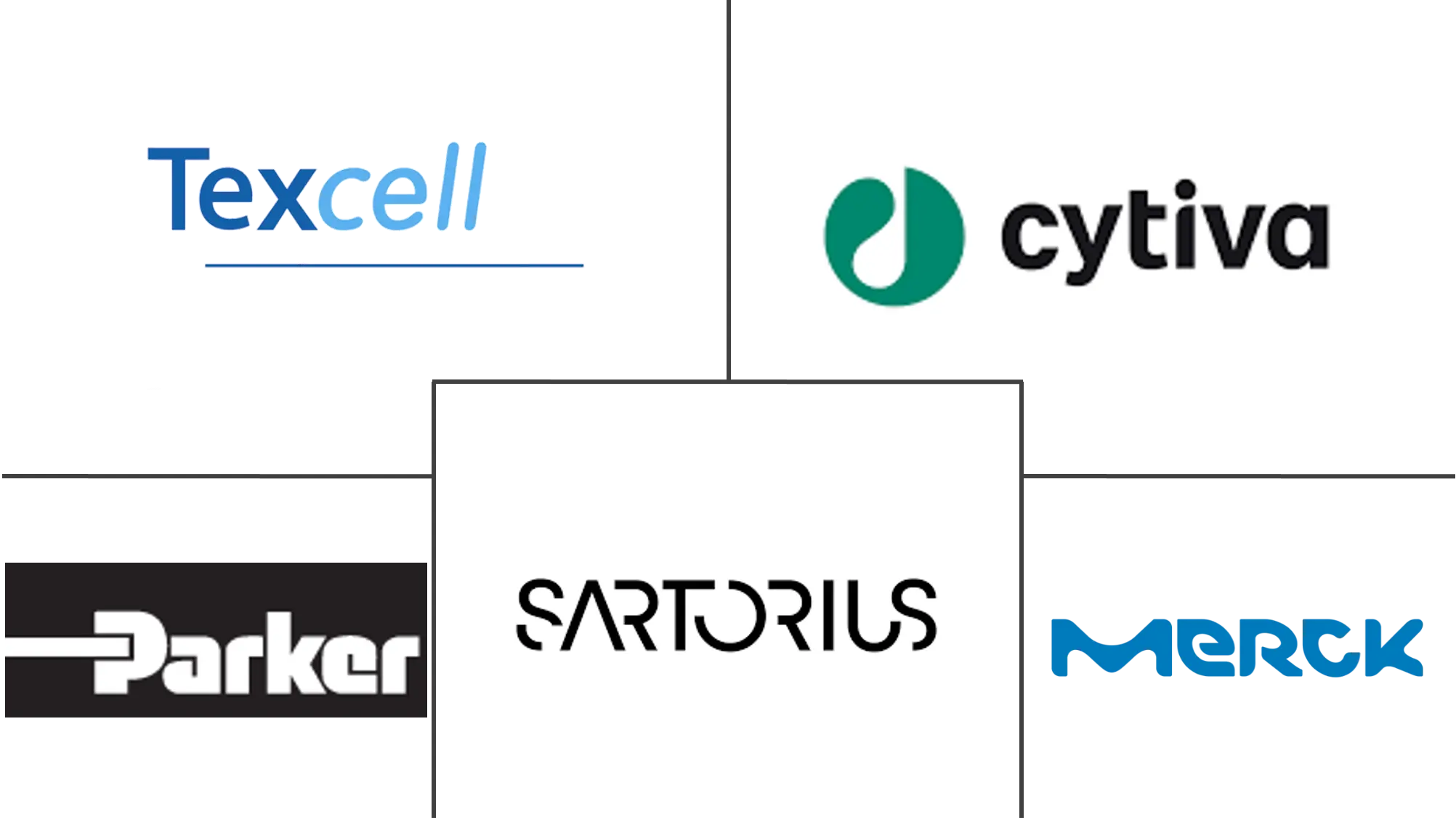Global Viral Inactivation Market Size and Share
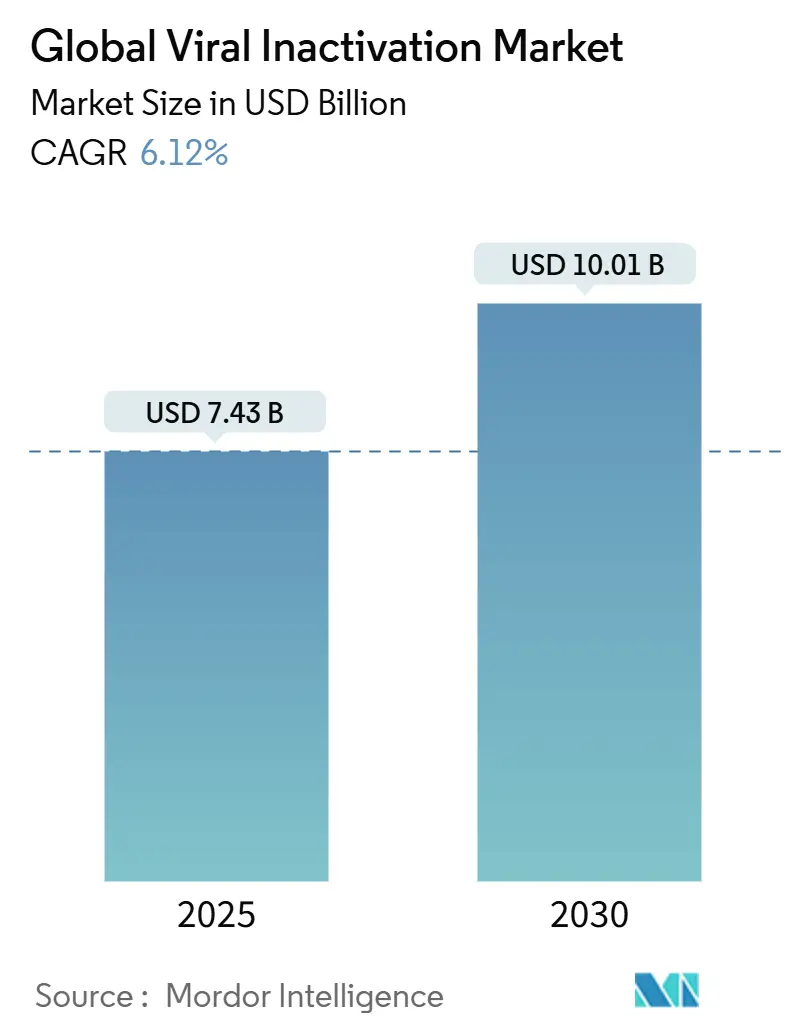
Global Viral Inactivation Market Analysis by Mordor Intelligence
The viral inactivation market stood at USD 7.43 billion in 2025 and is projected to advance at a 6.12% CAGR, reaching USD 10.01 billion by 2030. Heightened biologics output, rising cell and gene therapy (CGT) volumes, and stricter global safety expectations give the market its present momentum. Demand accelerates as regulators phase out legacy detergents such as Triton X-100, steering manufacturers toward environmentally compatible chemistries and heat-based approaches. Outsourcing of viral clearance work to specialist laboratories is rising in parallel with rapid CDMO expansion, especially in Asia-Pacific, where large-scale viral vector capacity is being built to attract Western biopharma projects. Competitive intensity continues to climb as leading filtration, reagent, and service suppliers broaden portfolios through targeted acquisitions aimed at the fast-growing CGT opportunity. The combined effect of these factors cements the viral inactivation market as an essential enabler of biopharmaceutical productivity and patient safety.
Key Report Takeaways
- By method, solvent–detergent technology led with 46.43% revenue share in 2024; pasteurization and heat treatment is set to expand at an 8.65% CAGR to 2030.
- By product, kits and reagents commanded 41.45% of the viral inactivation market share in 2024, while validation and testing services are forecast to grow 8.93% annually to 2030.
- By application, vaccines and therapeutics accounted for 49.54% of the viral inactivation market size in 2024; cellular and gene therapy products are advancing at 8.88% CAGR through 2030.
- By end-user, biopharma and biotechnology firms held 53.45% demand in 2024; CDMOs record the highest projected CAGR at 9.76% through 2030.
- Regionally, North America retained 42.12% share in 2024, whereas Asia-Pacific is on track for a 7.45% CAGR to 2030.
Global Viral Inactivation Market Trends and Insights
Driver Impact Analysis
| Driver | % Impact on CAGR Forecast | Geographic Relevance | Impact Timeline |
|---|---|---|---|
| Expansion of biologics and gene therapy pipelines | +1.8% | Global (North America & Europe lead) | Medium term (2-4 years) |
| Rising incidence of viral contamination recalls | +1.2% | Global (regulated markets) | Short term (≤ 2 years) |
| Stringent global regulatory mandates for viral safety | +1.5% | Global (FDA, EMA, expanding APAC) | Long term (≥ 4 years) |
| Shift toward single-use bioprocessing platforms | +0.9% | North America & Europe, spreading to APAC | Medium term (2-4 years) |
| Phase-out of Triton X-100 driving alternative solutions | +0.6% | EU-driven, worldwide adoption | Short term (≤ 2 years) |
| Venture capital funding for viral vector CDMOs & start-ups | +0.8% | North America (spill-over to APAC) | Medium term (2-4 years) |
| Source: Mordor Intelligence | |||
Expansion of Biologics and Gene Therapy Pipelines
Pipeline growth remains the prime catalyst for the viral inactivation market. More than 1,200 active US CGT clinical studies were registered in 2024, underlining unprecedented therapeutic breadth. CGT approvals, now totaling 37 in the United States, multiply viral clearance workloads because each vector platform must satisfy orthogonal inactivation tests. The pivot from treating rare disorders toward prevalent diseases such as heart failure demands higher batch volumes, forcing manufacturers to implement scalable safety solutions early in development. Adeno-associated virus programs illustrate the complexity, often requiring low-pH, solvent–detergent, and heat-hold combinations to satisfy regulators. As CGT facilities proliferate worldwide, every incremental clinical candidate feeds steady service revenue for viral inactivation experts.
Rising Incidence of Viral Contamination Recalls
Manufacturing lapses continue to trigger costly drug recalls, with 2,900 sterile product withdrawals recorded globally between 2018 and 2023[1]U.S. Food & Drug Administration, “Drug Recall Enforcement Reports,” fda.gov. Warning letters sent to multinational producers in 2024 and 2025 show that inadequate clearance protocols remain an issue even in mature plants. A single contamination event can halt multi-site production and generate USD 100 million or more in corrective costs, making redundancy a better economic choice than remediation. Firms now implement continuous in-line virus filters, automated sampling, and environmental monitoring to cut incident probability. Insurance carriers have started linking policy premiums to validated viral safety infrastructure, adding financial motivation to upgrade processes swiftly.
Stringent Global Regulatory Mandates for Viral Safety
Revision Q5A(R2) enforces deeper risk-based viral evaluation for biotechnology products and heightens data expectations in licence filings. Concurrently, the European Chemicals Agency’s REACH program bans manufacturing use of Triton X-100 for environmental reasons, obligating companies to re-validate detergent steps with greener options. China’s National Medical Products Administration is mirroring Western requirements, compelling domestic CDMOs to overhaul viral clearance laboratories to stay globally competitive. Harmonisation efforts across ICH regions, though beneficial long term, temporarily raise development complexity and prolong dossier preparation schedules. Suppliers that can deliver proven inactivation packages compliant across jurisdictions gain a decisive advantage.
Shift Toward Single-Use Bioprocessing Platforms
Single-use assemblies have moved well beyond early adoption and now anchor most new mammalian facilities, directly altering viral safety strategies. Disposable reactors and downstream modules lessen contamination risk because they arrive pre-sterilised, eliminating equipment turnaround. Viral inactivation tanks sized to single-use batches shorten hold times and speed changeovers, boosting facility utilisation. Smaller biotech firms benefit most, avoiding USD 50 million stainless-steel investments while maintaining regulatory compliance. The trend also fuels demand for ready-to-use inactivation buffers, closed-system heaters, and gamma-stable plastic tubing, opening new revenue streams for component makers.
Restraints Impact Analysis
| Restraints Impact Analysis | (~) % Impact on CAGR Forecast | Geographic Relevance | Impact Timeline |
|---|---|---|---|
| High capital expenditure for advanced inactivation infrastructure | -0.8% | Global (small & mid-size manufacturers most affected) | Long term (≥ 4 years) |
| Complex and lengthy validation & regulatory approval cycles | -1.1% | Global (jurisdictional variation) | Medium term (2-4 years) |
| Supply-chain volatility of GMP-grade detergents and filters | -0.7% | Global (heightened in EU & Asia) | Short term (≤ 2 years) |
| Technical challenges in continuous inline viral inactivation setup | -0.9% | North America & Europe early adopters | Medium term (2-4 years) |
| Source: Mordor Intelligence | |||
High Capital Expenditure for Advanced Inactivation Infrastructure
Full-scale viral safety suites incorporating BSL-2 labs, heat-hold tanks, nanofiltration skids, and orthogonal testing instruments can exceed USD 50 million, putting the build-or-buy decision under intense scrutiny for small entities. Cash-constrained sponsors often defer investment, but late retrofits risk launch delays if clearance studies fail to meet regulatory acceptance criteria. Even after equipment purchase, ongoing calibration, biosafety certification, and skilled personnel costs remain high. The burden widens the capability gap between large integrated biopharma groups and emerging enterprises, accelerating outsourcing and market consolidation.
Complex and Lengthy Validation and Regulatory Approval Cycles
A single viral clearance study can span 18 months, requiring multiple model viruses, worst-case process parameters, and exhaustive statistical proof that cumulative reduction meets clearance targets. Added to analytical testing lead times, dossier review, and potential agency questions, the timeline can postpone commercial launch well beyond original projections. Limited global contract capacity for category-C viruses means sponsors often queue for laboratory slots, extending schedules further. These delays carry tangible net-present-value penalties for asset owners and can deter investment in marginal therapeutic candidates.
Segment Analysis
By Method: Heat Treatment Gains Momentum Despite Solvent–Detergent Dominance
Solvent–detergent procedures secured 46.43% of revenue in 2024, affirming their role as the default approach for lipid-enveloped viral clearance in plasma-derived and recombinant protein products[2]Canadian Blood Services, “Solvent–Detergent Inactivation in Plasma Processing,” blood.ca. Their validated performance profile sustains adoption, particularly where legacy processes face minimal changes. However, pasteurization and related heat modalities are advancing at an 8.65% CAGR as sustainability imperatives reshape process selection. This growth elevates the viral inactivation market size for heat-based equipment suppliers, supported by improved formulations that protect labile proteins during 60 °C holds. Parallel interest in low-pH and caprylate methods persists for monoclonal antibodies where gentle conditions guard Fc functionality.
The European prohibition of Triton X-100 accelerates uptake of alternatives such as Virodex™ detergents and Deviron® reagents, yet heat remains the most regulation-agnostic route. Manufacturers adopt hybrid strategies combining a detergent step with terminal pasteurization to secure orthogonal log reduction credits. Research efforts exploring high hydrostatic pressure for viral vaccines suggest longer-term method diversification opportunities that could widen the viral inactivation market, provided scalability hurdles are addressed[3]Nature Research, “High Hydrostatic Pressure as a Viral Inactivation Tool,” nature.com.
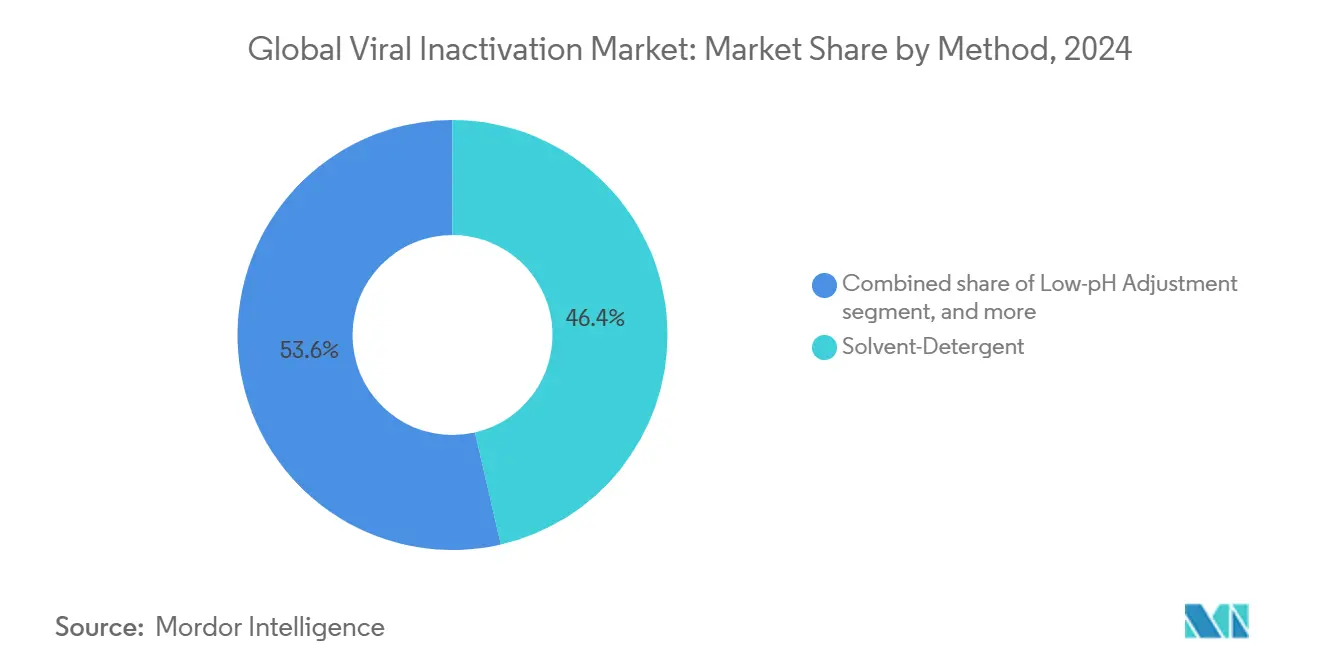
Note: Segment shares of all individual segments available upon report purchase
By Product: Services Segment Accelerates as Validation Complexity Increases
Kits and reagents delivered 41.45% revenue in 2024, reflecting baseline consumable demand across every licensed bioprocess. Concentrated formulations and single-use conditioning bags sustain volume despite detergent reformulation mandates. Validation and testing services, on the other hand, are forecast to grow 8.93% annually, lifting the viral inactivation market size for external laboratories that offer end-to-end clearance packages. Their appeal rises as regulatory guidance intensifies data expectations and as in-house BSL-2 capacity remains scarce.
Leading providers supply modular study designs, predictive viral reduction modeling, and GMP-compliant reporting templates, eliminating months from project timelines. Demand for virus inactivation systems—closed-loop heaters, nanofilters, and skid-mounted low-pH reactors—also expands in synchrony with the single-use movement, but services capture disproportionate growth because they embed technical expertise that is difficult to replicate in silico or on-premise.
By Application: Cell and Gene Therapy Drives Next-Generation Demand
Vaccines and therapeutics comprised 49.54% of 2024 consumption by value, benefitting from high-volume influenza and COVID-19 campaigns that deploy integrated solvent–detergent or low-pH holds in standard manufacturing scripts. These mature products continue to underpin the viral inactivation market, yet their CAGR trails CGT because they sit on optimized lines with little room for margin expansion. Cellular and gene therapy modalities are projected to scale at 8.88% CAGR, making them the single fastest-growing demand driver within the viral inactivation industry.
Vector-rich harvests challenge operators to maintain replication competency below detection limits while safeguarding therapeutic potency. Solutions often combine depth filtration, DNAse treatment, and targeted low-pH incubation alongside size-exclusion nanofiltration. Service companies offering fit-for-purpose CGT clearance protocols are therefore capturing premium contracts, while equipment makers develop high-throughput systems capable of processing small, multi-product CGT batches efficiently.
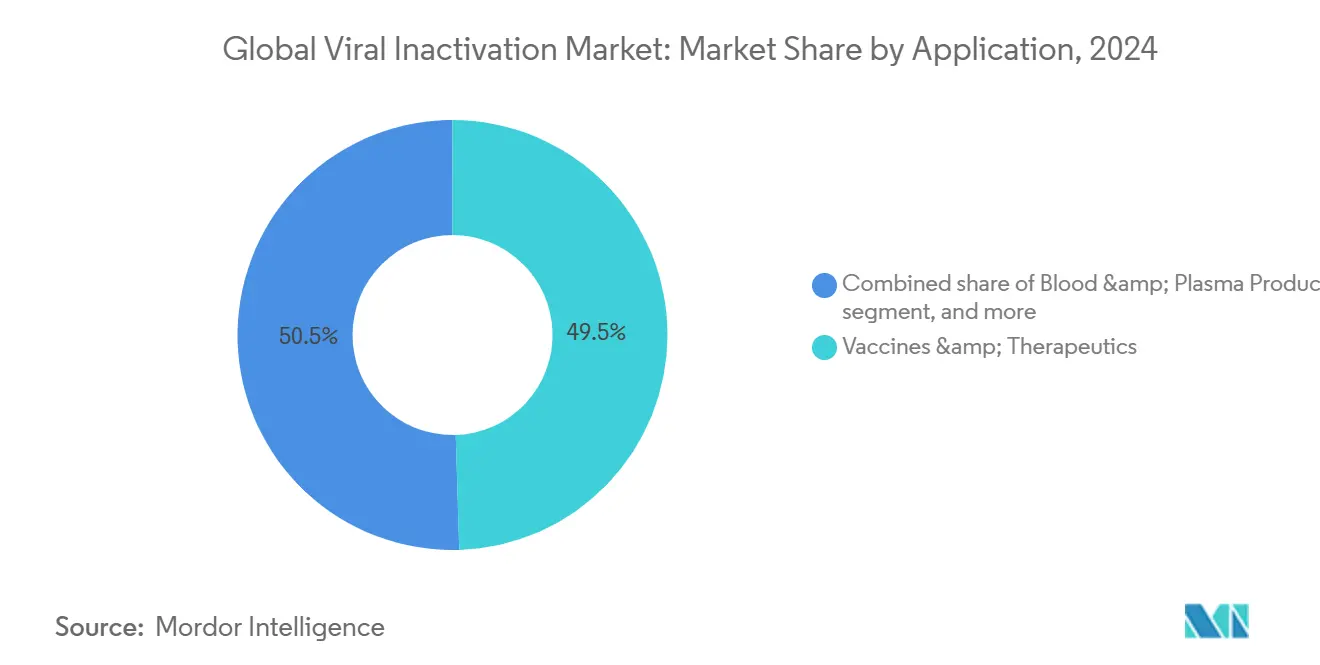
Note: Segment shares of all individual segments available upon report purchase
By End-User: CDMOs Capitalize on Outsourcing Trends
Biopharma and biotech firms remained the predominant clientele in 2024, absorbing 53.45% of total spend as they retain ultimate regulatory accountability for product safety. Their internal capacity focus rests on flagship assets, leaving room for third-party collaborators to manage overflow and specialized assays. CDMOs display a forecast 9.76% CAGR, the highest among end-users, fuelled by Western sponsors shifting operations to Indian and Singaporean plants to mitigate geopolitical risk tied to China-centric supply chains.
CGT-focused CDMOs are raising venture funding to build purpose-built facilities that integrate vector production, inactivation, and clearance testing on a single campus. Their expansion raises barriers for small, standalone testing laboratories while consolidating market power within multi-service contract players. CROs maintain a stable niche supporting pre-clinical proof-of-concept batches, although they increasingly partner with CDMOs to present unified offerings to clients.
Geography Analysis
North America preserved 42.12% revenue share in 2024 and continues to anchor the viral inactivation market through advanced CGT clusters in Massachusetts, North Carolina, and California. FDA enforcement, exemplified by Q5A(R2), drives rapid adoption of orthogonal inactivation and inline nanofiltration, sustaining premium demand for high-specification consumables. Strategic capital projects such as Novo Nordisk’s USD 4.1 billion fill-finish expansion in Clayton, North Carolina, embed large-scale viral safety suites that lock in multiyear consumable spend. Thermo Fisher Scientific’s USD 4.1 billion purchase of Solventum’s Purification & Filtration portfolio in February 2025 further concentrates capability in the region and augments integrated clearance solutions.
Asia-Pacific registers the steepest trajectory with a 7.45% CAGR to 2030, buoyed by local policy incentives that accelerate biologics self-sufficiency. India’s CDMO market, valued at USD 15.63 billion in 2023 and headed for USD 26.73 billion by 2028, fuels a rapid rise in BSL-2 laboratory construction and integrated viral clearance services. Meanwhile, China’s Anti-Espionage Law, effective July 2023, complicates foreign GMP inspections, pushing Western buyers to diversify supply chains, yet domestic demand for viral clearance technologies remains robust amid the country’s Five-Year Biotech Plan. Japanese regulators’ early endorsement of Triton-X alternatives accelerates heat-based process validation in local plasma plants, highlighting varied regional technology preferences.
Europe delivers modest but steady expansion as the REACH directive spurs detergent reformulation projects that translate directly into viral inactivation market demand for validation studies. Companies such as Croda and Asahi Kasei lead the response by launching compliant surfactants and ultrafast Planova FG1 filters designed for high-volume monoclonal antibody facilities. State-sponsored innovation grants in Germany and France encourage local SMEs to pilot continuous viral inactivation reactors, although capital intensity constrains scale-up pace relative to North American initiatives.
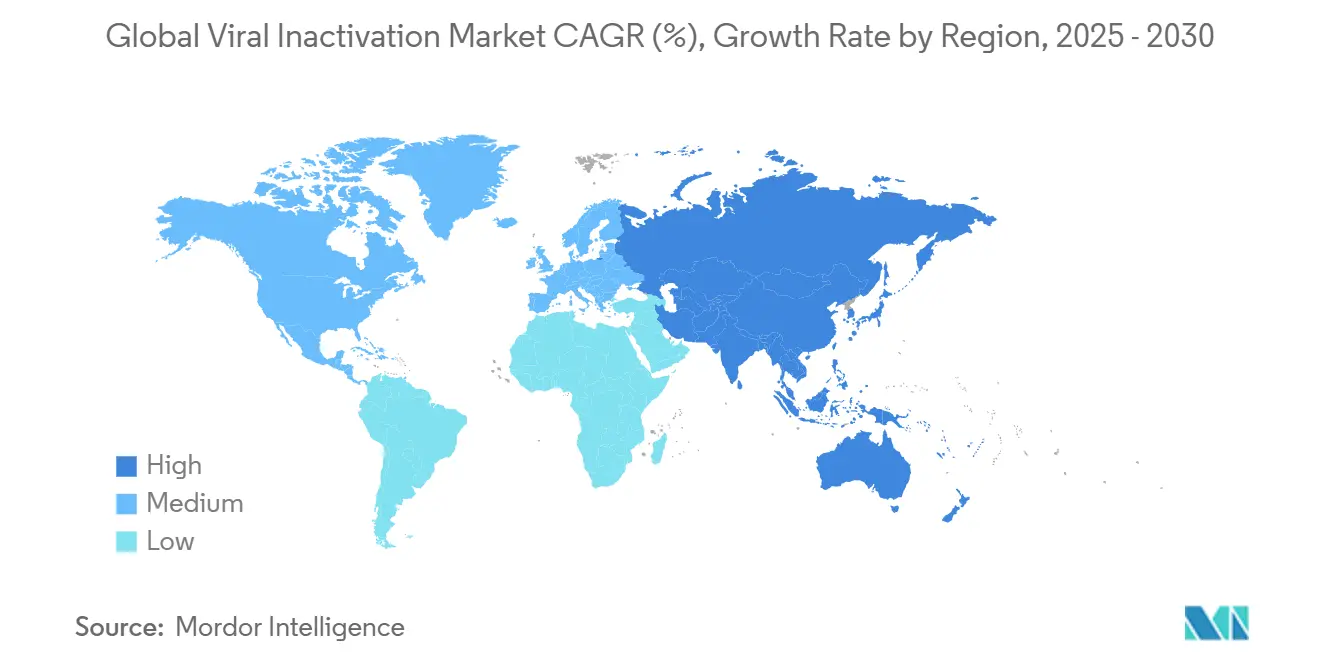
Competitive Landscape
The viral inactivation market is moderately concentrated, with the top five suppliers estimated to hold 55–60% combined revenue. Danaher’s 2024 integration of Cytiva and Pall created a USD 7.5 billion bioprocessing division offering filtration, chromatography, and single-use assemblies that collectively address every viral clearance checkpoint. Thermo Fisher’s recent filtration acquisition enlarges its catalog of heat-stable bags, depth filters, and detergent blends, positioning it as a one-stop viral safety partner for emerging CGT manufacturers. Sartorius complements upstream bioreactors with downstream nanofiltration modules and statistical clearance software, underscoring the trend toward platform ecosystems.
Service providers target higher-margin niches. Charles River Laboratories strengthened its viral vector footprint through the USD 292.5 million purchase of Vigene Biosciences in 2024, enabling integrated GMP production, inactivation, and potency testing under one quality system. Merck KGaA’s USD 600 million acquisition of Mirus Bio the same year supplied patented transfection reagents that boost vector titres, indirectly raising subsequent inactivation workloads. Lonza continues organic build-outs, citing more than 70 viral vector development projects executed since 2023, and invests in rapid-cycle low-pH skids to differentiate on clearance throughput.
Technological competition coalesces around sustainability and process economics. Croda’s Virodex detergents and Asahi Kasei’s Planova FG1 filter underscore the pivot toward greener, faster alternatives that reduce buffer use and cycle times. Emerging players pursue high-hydrostatic-pressure, photochemical, and enzymatic solutions aimed at fragile CGT cargoes, yet widespread adoption awaits cost proofs at commercial scale. Organizations able to bundle equipment, reagents, software, and services in a single contract increasingly secure preferred-vendor status during facility design reviews, tightening barriers for niche newcomers.
Global Viral Inactivation Industry Leaders
-
Merck KGaA
-
Sartorius AG
-
Texcell SA
-
Cytiva (Danaher Corporation)
-
Parker Hannifin Corp
- *Disclaimer: Major Players sorted in no particular order
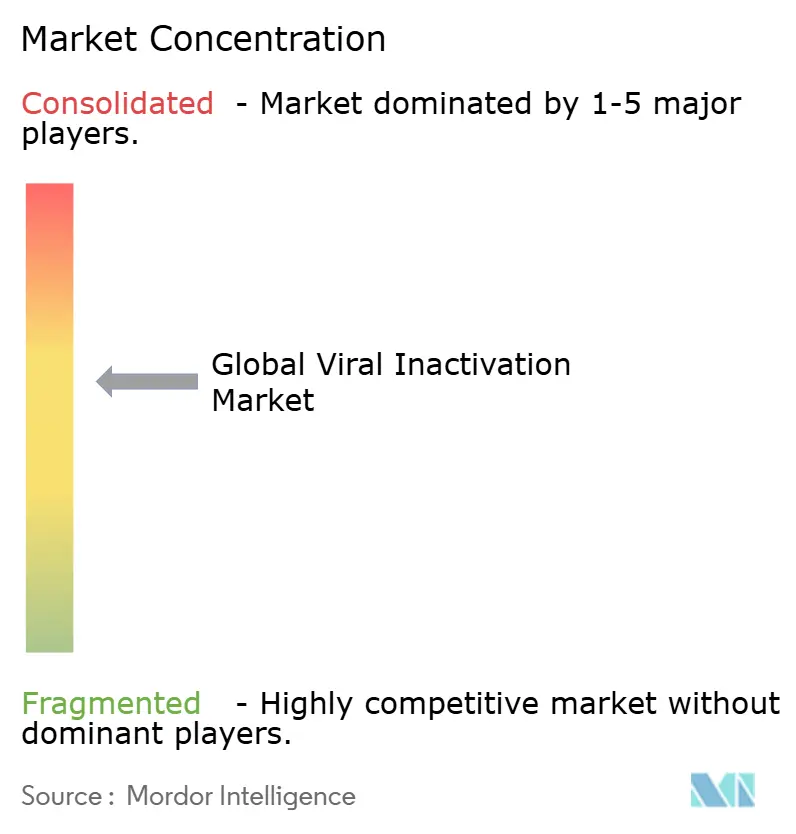


Recent Industry Developments
- February 2025: Thermo Fisher Scientific acquired Solventum’s Purification & Filtration business for roughly USD 4.1 billion, expanding its bioproduction and viral clearance capabilities.
- January 2025: Croda launched the Virodex™ range, offering Triton X-100-free surfactants that meet EU REACH compliance for viral inactivation workflows.
- August 2024: ViroCell Biologics closed an oversubscribed convertible note to scale GMP viral vector production after UK MHRA licensure.
- July 2024: Avantor released J.T.Baker® Cell Lysis Solution and Endonuclease to enhance AAV harvest efficiency with lower environmental impact.
- May 2024: Merck KGaA completed its USD 600 million acquisition of Mirus Bio, strengthening viral vector manufacturing technologies.
Research Methodology Framework and Report Scope
Market Definitions and Key Coverage
Our study defines the viral inactivation market as the sale of reagents, dedicated systems, and verification services that render contaminating viruses non-infectious during biopharmaceutical and vaccine manufacturing. This step is modeled only when its purpose is outright inactivation rather than removal or detection.
Scope exclusion: Stand-alone viral removal filters or nucleic-acid detection assays that do not integrate an inactivation procedure are excluded.
Segmentation Overview
- By Method
- Solvent-Detergent
- Low-pH Adjustment
- Pasteurization / Heat
- Other Methods
- By Product
- Viral Inactivation Systems and Accessories
- Kits & Reagents
- Validation & Testing Services
- Other Products
- By Application
- Vaccines & Therapeutics
- Blood & Plasma Products
- Cellular & Gene-Therapy Products
- Other Applications
- By End-User
- Biopharma & Biotechnology Companies
- Contract Development & Manufacturing Organisations (CDMOs)
- Contract Research Organisations (CROs)
- Other End-Users
- Geography
- North America
- United States
- Canada
- Mexico
- Europe
- Germany
- United Kingdom
- France
- Italy
- Spain
- Rest of Europe
- Asia-Pacific
- China
- Japan
- India
- Australia
- South Korea
- Rest of Asia-Pacific
- Middle East & Africa
- GCC
- South Africa
- Rest of Middle East & Africa
- South America
- Brazil
- Argentina
- Rest of South America
- North America
Detailed Research Methodology and Data Validation
Primary Research
We engaged quality-control leads at contract development manufacturers, regulatory reviewers in North America and Europe, and process engineers at Asian vaccine plants. Their inputs clarified kit utilization rates, solvent-detergent phase-out timelines, and pricing pass-throughs that raw desk data could not fully explain. These dialogues also validated early model outputs before sign-off.
Desk Research
Mordor analysts began with public-domain pillars such as FDA process validation guidance, EMA Q5A(R2) revision notes, WHO Technical Report Series on biologicals, and CDC Biologics Red Book to frame regulatory baselines. Trade statistics for plasma-derived products from UN Comtrade, annual biologics approvals collated by the European Federation of Pharmaceutical Industries, and peer-reviewed journals in PubMed added volume trend context. Company 10-Ks, investor decks, and press releases then supplied average selling price ranges and capacity expansion news. Subscription sources, including D&B Hoovers for producer revenues and Dow Jones Factiva for transaction alerts, helped triangulate kit pricing and regional uptake. The listed references illustrate our desk work, yet many additional publications were consulted as needed.
Market-Sizing & Forecasting
A top-down construct starts with global commercial biologic batch volumes, rebuilt from licensed product outputs and average media requirements. Viral inactivation step prevalence factors are then applied. Results are cross-checked bottom-up by rolling up leading supplier revenues and sampled ASP × volume calculations to keep totals grounded. Variables that drive the model include new biologic approvals, installed single-use bioreactor liters, average kit cost per liter treated, regional GMP facility counts, and regulatory inspection frequency trends. Five-year projections employ a multivariate regression marrying biologics R&D spend, capital expansion announcements, and tightening viral safety guidelines, which our experts reviewed for plausibility. Any bottom-up gaps are filled through conservative interpolation using nearest peer benchmarks.
Data Validation & Update Cycle
Analysts run variance and anomaly screens, compare outputs against external biologics production indices, and escalate discrepancies for senior review. Reports refresh every twelve months, with interim recalculations if major regulation or contamination events occur. A final analyst check ensures clients receive the freshest market view.
Why Mordor's Viral Inactivation Baseline Earns Stakeholder Confidence
Published estimates often diverge because providers pick different scopes, input signals, and refresh rhythms.
Key gap drivers stem from whether services are bundled with removal tests, the aggressiveness of kit price erosion assumptions, and how producers translate regional currencies into USD. Mordor reports current demand, whereas some outlets publish partial segments or older study years, leading to headline gaps.
Benchmark comparison
| Market Size | Anonymized source | Primary gap driver |
|---|---|---|
| USD 7.43 billion | Mordor Intelligence | - |
| USD 0.793 billion | Regional Consultancy A | Narrow geographic cut to North America and vaccines only |
| USD 1.28 billion | Trade Journal B | Relies chiefly on patent counts; limited primary validation |
| USD 5.47 billion | Global Consultancy C | Bundles viral removal and detection within totals, inflating overlap |
The comparison shows that our disciplined scope selection, dual-sourced variables, and annual refresh cadence deliver a balanced, transparent baseline that decision-makers can trace back to clear assumptions.


Key Questions Answered in the Report
What is the projected value of the viral inactivation market by 2030?
The market is forecast to reach USD 10 billion by 2030, expanding at a 6.12% CAGR.
Which viral inactivation method is growing the fastest?
Pasteurization and other heat-based approaches show the highest growth, with an expected 8.65% CAGR through 2030.
Why is Asia-Pacific the fastest-growing region?
Expanding CDMO infrastructure, supportive government policies, and supply-chain diversification from China toward India drive a 7.45% regional CAGR.
How does Triton X-100’s phase-out affect manufacturers?
Companies must re-validate processes using new detergents such as Virodex™ or shift to heat methods, increasing demand for validation services.
Which end-user segment will grow quickest?
CDMOs lead with a 9.76% CAGR as biopharma sponsors outsource complex viral clearance work to specialised providers.
What score describes market concentration, and why?
A score of 6 reflects moderate concentration; the top five firms hold near-60% revenue while numerous specialist and regional companies remain competitive.
Page last updated on:
